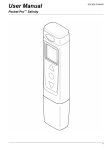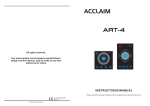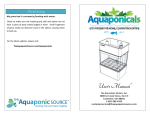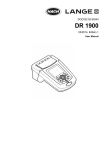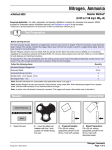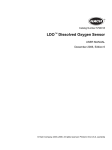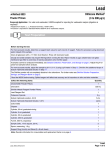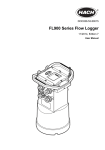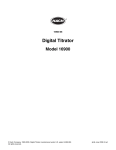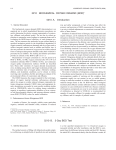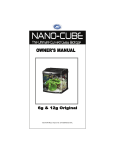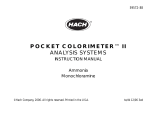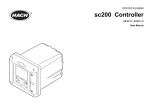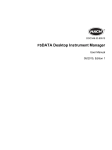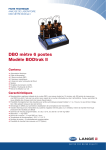Download Hach Lange BOD Trak II User Manual
Transcript
DOC022.52.80363 BODTrak II™ 02/2013, Edition 1 User Manual Table of Contents Specifications ..................................................................................................................................................................................5 General information .....................................................................................................................................................................5 Safety information ..............................................................................................................................................................................5 Use of hazard information ..................................................................................................................................................................6 Precautionary labels ..........................................................................................................................................................................6 Certification ........................................................................................................................................................................................6 Product overview ...............................................................................................................................................................................7 Product components ..........................................................................................................................................................................7 Installation .........................................................................................................................................................................................7 External connections ..........................................................................................................................................................................7 Connect the RS232 interface .............................................................................................................................................................8 Bottle connections ..............................................................................................................................................................................8 User interface ..................................................................................................................................................................................8 Channel selection keys ......................................................................................................................................................................9 Arrow keys .........................................................................................................................................................................................9 ON key ...............................................................................................................................................................................................9 OFF key .............................................................................................................................................................................................9 Startup .................................................................................................................................................................................................9 Turn the instrument on .......................................................................................................................................................................9 Set the clock ......................................................................................................................................................................................9 Standard operation ....................................................................................................................................................................10 Download test results .......................................................................................................................................................................10 Import data .......................................................................................................................................................................................10 Data format ......................................................................................................................................................................................10 Print test results ...............................................................................................................................................................................11 BODTrak II™ procedures ........................................................................................................................................................11 Procedure notes ...............................................................................................................................................................................11 Simplified procedure ........................................................................................................................................................................12 Hach GGA (glucose/glutamic acid) procedure .................................................................................................................................13 1 Table of Contents Hach Standard Method procedure ...................................................................................................................................................14 Completion steps for all procedures ................................................................................................................................................15 Determination of results .........................................................................................................................................................17 Simplified sample results .................................................................................................................................................................17 Hach GGA (glucose/glutamic acid) results ......................................................................................................................................17 Hach Standard Method results ........................................................................................................................................................17 Typical curves ...............................................................................................................................................................................17 Special considerations ............................................................................................................................................................18 Sample dilution ................................................................................................................................................................................18 Sample seeding ...............................................................................................................................................................................18 Sample temperature ........................................................................................................................................................................18 Toxic materials .................................................................................................................................................................................18 Chlorine ............................................................................................................................................................................................19 pH effect ...........................................................................................................................................................................................19 Supersaturation ................................................................................................................................................................................19 Maintenance ...................................................................................................................................................................................19 Clean the instrument ........................................................................................................................................................................19 Clean the sample bottles .................................................................................................................................................................19 Clean the stir bars and seal cups .....................................................................................................................................................19 Storage ............................................................................................................................................................................................19 Troubleshooting ..........................................................................................................................................................................20 Incorrect BOD curves .......................................................................................................................................................................20 High oxygen demand .......................................................................................................................................................................20 Nitrification .......................................................................................................................................................................................21 Excessive time lag ...........................................................................................................................................................................21 Sample temperature ........................................................................................................................................................................21 Bottle leak ........................................................................................................................................................................................21 Replacement parts and accessories ...............................................................................................................................21 Replacement parts ...........................................................................................................................................................................21 Required reagents ...........................................................................................................................................................................22 2 Table of Contents Optional reagents .............................................................................................................................................................................22 Accessories ......................................................................................................................................................................................22 3 Table of Contents 4 Specifications Specifications are subject to change without notice. Table 1 General Specifications Table 2 Method performance specifications Specification Details Precision Parameters: • • • • Standard: 150 mg/L each of glucose and glutamic acid Number of samples: 44 Number of analysts: 1 Number of BodTrak II instruments: 6 Specification Details Operating temperature 5 to 40 ºC (41 to 104 ºF) Altitude limit 2000 m (6500 ft) Pollution degree 2 Installation category II Storage/operating humidity Maximum relative humidity is 80% for temperatures up to 31 ºC (87.8 ºF), decreases linearly to 50% relative humidity at 40 ºC (104 ºF) Location Laboratory / Indoor Protection class 2 General information Range Selectable, 0 to 35, 0 to 70, 0 to 350, 0 to 700 mg/L Dimensions 28.9 x 26 x 9.8 cm (11.375 x 10.25 x 3.875 in.) External power supply Input: 100 to 240 VAC, 50/60 Hz, 1.5 A; Output: 24 VDC, 2.7 A, UL CSA and TUV approved. Capacity Six 492 mL bottles In no event will the manufacturer be liable for direct, indirect, special, incidental or consequential damages resulting from any defect or omission in this manual. The manufacturer reserves the right to make changes in this manual and the products it describes at any time, without notice or obligation. Revised editions are found on the manufacturer’s website. Shipping weight 4 kg (8.8 lb) Warranty 1 year Results: • Mean of 235 mg/L BOD • Distribution: 11 mg/L or range of 224 to 246 mg/L BOD • 95% confidence limit Drift Less than 3 mg/L BOD in 5 days Resolution 1 mg/L BOD Safety information NOTICE The manufacturer is not responsible for any damages due to misapplication or misuse of this product including, without limitation, direct, incidental and consequential damages, and disclaims such damages to the full extent permitted under applicable law. The user is solely responsible to identify critical application risks and install appropriate mechanisms to protect processes during a possible equipment malfunction. Please read this entire manual before unpacking, setting up or operating this equipment. Pay attention to all danger and caution statements. English 5 Failure to do so could result in serious injury to the operator or damage to the equipment. Make sure that the protection provided by this equipment is not impaired. Do not use or install this equipment in any manner other than that specified in this manual. Use of hazard information DANGER Indicates a potentially or imminently hazardous situation which, if not avoided, will result in death or serious injury. WARNING Indicates a potentially or imminently hazardous situation which, if not avoided, could result in death or serious injury. CAUTION Indicates a potentially hazardous situation that may result in minor or moderate injury. NOTICE Indicates a situation which, if not avoided, may cause damage to the instrument. Information that requires special emphasis. Precautionary labels Read all labels and tags attached to the instrument. Personal injury or damage to the instrument could occur if not observed. A symbol on the instrument is referenced in the manual with a precautionary statement. This symbol, if noted on the instrument, references the instruction manual for operation and/or safety information. Electrical equipment marked with this symbol may not be disposed of in European public disposal systems after 12 August of 2005. In conformity with European local and national regulations (EU Directive 2002/96/EC), European electrical equipment users must now return old or end-of-life equipment to the Producer for disposal at no charge to the user. Note: For return for recycling, please contact the equipment producer or supplier for instructions on how to return end-of-life equipment, producer-supplied electrical accessories, and all auxiliary items for proper disposal. Certification Canadian Radio Interference-Causing Equipment Regulation, IECS-003, Class A: Supporting test records reside with the manufacturer. This Class A digital apparatus meets all requirements of the Canadian Interference-Causing Equipment Regulations. Cet appareil numèrique de la classe A respecte toutes les exigences du Rëglement sur le matériel brouilleur du Canada. FCC Part 15, Class "A" Limits Supporting test records reside with the manufacturer. The device complies with Part 15 of the FCC Rules. Operation is subject to the following conditions: 1. The equipment may not cause harmful interference. 2. The equipment must accept any interference received, including interference that may cause undesired operation. Changes or modifications to this equipment not expressly approved by the party responsible for compliance could void the user's authority to operate the equipment. This equipment has been tested and found to comply with the limits for a Class A digital device, pursuant to Part 15 of the FCC rules. These limits are designed to provide reasonable protection against harmful interference when the equipment is operated in a commercial environment. This equipment generates, uses and can radiate radio frequency energy and, if not installed and used in 6 English accordance with the instruction manual, may cause harmful interference to radio communications. Operation of this equipment in a residential area is likely to cause harmful interference, in which case the user will be required to correct the interference at their expense. The following techniques can be used to reduce interference problems: The instrument adjusts for any negative errors produced when heat is applied to a sample. The instrument does not start the test until the temperature gets to equilibrium. 1. Disconnect the equipment from its power source to verify that it is or is not the source of the interference. 2. If the equipment is connected to the same outlet as the device experiencing interference, connect the equipment to a different outlet. 3. Move the equipment away from the device receiving the interference. 4. Reposition the receiving antenna for the device receiving the interference. 5. Try combinations of the above. Make sure that all components have been received. If any of these items are missing or damaged, contact the manufacturer or a sales representative immediately. Product overview Respirometric Biological Oxygen Demand (BOD) is a test that measures the quantity of oxygen consumed by bacteria that oxidize organic matter in a water sample. The test is used to measure waste loadings at wastewater treatment plants and to examine the efficiency of wastewater treatment. The instrument is sealed to prevent external atmospheric pressure changes in the test bottle. The pressure in the sample bottles is monitored. Bacteria in the sample use oxygen when they consume organic matter. This oxygen consumption causes the pressure in the bottle head space to drop. The pressure drop correlates directly to BOD. During a test period, stir bars mix the sample and cause oxygen to move from the air in the bottle to the sample. This helps simulate natural conditions. Carbon dioxide is a result of the oxidation process and can interfere with a measurement. The instrument continuously removes carbon dioxide from the system so that the monitored pressure difference stays proportional to the quantity of oxygen used. Pressure changes in the closed system are shown graphically in milligrams per liter (mg/L) on a liquid crystal display. The instrument gives 360 uniform data points over the selected time period. Product components • BODTrak™ II instrument • A UL/CSA approved 115 VAC power cord with a NEMA 5-15P style plug • A 230 VAC harmonized power cord with a continental European plug • Power supply, auto-switching between 115 V and 230 V • Seal cups (6x) • BODTrak II amber sample bottles (6x) • BODTrak II magnetic stir bars (6x) • Spatula scoop • Nutrient buffer solution pillows (1 pkg) • Potassium hydroxide pellets (1 container) Installation External connections Figure 1 shows the locations of the power switch and external connections. English 7 Note: The use of the specified cable or an equivalent shielded cable is necessary to meet radio frequency emissions requirements. Figure 1 External connections Bottle connections Each bottle position/channel has the applicable tube numbered with a plastic sleeve. The bottle positions are numbered 1 through 6 with number 1 in the back left corner of the chassis. Use the channel selection keys as a guide to the bottle positions Figure 2 on page 8. User interface The instrument display and the keypad are shown in Figure 2. Figure 2 Display and keypad 1 Power switch 3 Serial I/O port 2 DC power connector Connect the RS232 interface 1 Display 4 Arrow keys All RS232 connections are made through the serial I/O port. Connect the 9-pin D connector of a computer interface cable to the serial I/O port on the instrument (Figure 1 on page 8). Connect the other end of the cable to the computer serial I/O port (COM 1 or COM 2). The instrument is equipped as Data Communication Equipment (DCE). The instrument operates at 9600 baud with 8 data bits, no parity and one stop bit. The computer or printer will not receive complete transmissions if the device cannot continuously receive at 9600 baud. 2 Channel selection keys 5 Power indicator 8 English 3 ON and OFF keys1 1 The ON and OFF keys are used to start and stop a test. They do not power the instrument on and off. Channel selection keys OFF key Push the related channel selection key to show data for one of the six bottles. The channel selection keys are also used in the instrument setup menu to select a parameter to be edited. Refer to Figure 2 on page 8 and Table 3. When a test is in DELAY or RUN modes, push and hold OFF to manually end the test. The instrument will show END. The OFF key is also used to exit the instrument setup menu or range selection menu. The changes made before the menu is exited are saved. Table 3 Channel key setup parameters Channel Parameter 1 Year (0–99) 2 Month (1–12) 3 Day (1–31) 4 Hour (0–24) 5 Minute (0–59) 6 Test length (5, 7 or 10 days) Arrow keys The display shows a graph of BOD values on the vertical axis and time in days on the horizontal axis. Push the LEFT and RIGHT arrows to move the cursor along the BOD curve to show the approximate coordinates (time, BOD) of the selected data point. The time interval and BOD value of the data point are shown in the lower right of the display. The cursor is automatically placed at the most recently collected data point in a channel display. Push and hold the LEFT and RIGHTarrows at the same time to go into the instrument setup menu. The arrow keys are also used to change the time, date, test length and range. Startup Turn the instrument on Note: The ON and OFF keys are used to start and stop a test. They do not power the instrument on and off. 1. Connect the power adaptor to the DC power connector (Figure 1 on page 8). 2. Toggle the power switch to set the instrument to on and off. (Figure 1 on page 8). Set the clock All the channels must show END or CLEAR before the clock can be set. 1. Push and hold the two arrow keys at the same time until the instrument setup menu is shown. 2. Push the applicable channel key to select the clock parameter to be adjusted. 3. Use the arrow keys to edit the selected parameter. Adjust each parameter in the same manner. 4. When all the time adjustments are complete, push OFF to save and go back to the data display screen. ON key To go to the range selection menu, push ON from a channel display screen. Then push and hold ON to start the test for the selected channel. English 9 Standard operation Download test results To transfer test results to a PC: 1. Select PROGRAMS>ACCESSORIES>COMMUNICATIONS>HYPERTERM INAL. 2. In the Connection Description window, type in a name for the connection and select an icon to represent the connection. Click OK. 3. In the Connect To window, use the drop-down menu to select the COM port connected to the instrument. Click OK. 4. Configure the COM port properties: BPS = 9600, Data Bits = 8, Parity = None, Stop Bits = 1, Flow Control = None. 5. Click OK. The connector indicator shows. 6. Select TRANSFER>CAPTURE TEXT. 7. In the Capture Text window, click START. 8. Power the instrument on. Push the key for the channel that has data to be downloaded. 9. Type GA in the HyperTerminal window and push ENTER. The transfer is complete when the screen stops adding new data. 10. Select TRANSFER>CAPTURE TEXT>STOP. 11. Select CALL>DISCONNECT. The disconnected indicator shows. 12. To end the HyperTerminal session, select FILE>EXIT. Import data 4. Click the check boxes for Space delimiter and Treat consecutive delimiters as one. Click NEXT. 5. Select General as the column data format, then click FINISH. 6. In the Import Data window, select Existing worksheet. Select the starting cell, then click OK. The data will appear in the spreadsheet. The spreadsheet data cannot be edited or formatted in HyperTerminal or with the BODTrak II. Data format When a result array is downloaded to HyperTerminal, all of the data from a test is sent without pause. The data flow cannot be stopped or paused. The example shows the channel number, start date, start time and the format of the downloaded data. BOD values in mg/L follow. Only the first data points of a maximum of 360 equal distance points are shown. Each line ends with a carriage return and a line feed. The end of the data stream is shown by a message such as "Test Run to Completion" and a dollar symbol ($). If small negative BOD values are seen at the start of a test, refer to Troubleshooting on page 20. Example of the data format BOD Log for Ch 1 Status: END Full Scale: 700 mg/L Tst length: 7 days Start Date: 3/3/08 Time: 13:04 To import the data from the captured text file: Days, Reading (mg/L) 1. Open a new or existing spreadsheet. Select DATA>IMPORT EXTERNAL DATA>IMPORT DATA. 2. Select the text file captured in HyperTerminal. Click IMPORT. 3. In the Text Import Wizard, select Delimited as the file type, the start row in the spreadsheet and Windows (ANSI) as the file origin. Click NEXT. 0.00, 0 0.05, 10 0.11, 12 0.16, 12 0.22, 14 0.27, 14 10 English 0.33, 12 0.38, 8 0.44, 10 0.50, 12 0.55, 12 0.61, 14 Test Run to Completion $ CAUTION Chemical exposure hazard. Dispose of chemicals and wastes in accordance with local, regional and national regulations. Procedure notes There are three procedure variations. Select the procedure that meets the application requirements. Print test results The BODTrak II is compatible with the Citizen PD-24 printer, which is available as an optional accessory (Accessories on page 22). 1. Connect the printer cable to the serial I/O port on the instrument. Use the gender adapter supplied with the printer to make the connection. Make sure that the printer settings are correct (Connect the RS232 interface on page 8). 2. Power on the instrument. 3. Push and hold the applicable channel number for approximately 5 seconds at any time during a test. The test results move from the instrument to the printer. The instrument sends a copy of the graphical display and a truncated data stream (127 data points). BODTrak II™ procedures CAUTION Chemical exposure hazard. Obey laboratory safety procedures and wear all of the personal protective equipment appropriate to the chemicals that are handled. Refer to the current material safety data sheets (MSDS) for safety protocols. • The Simplified procedure is recommended when sample seeding, extra nutrients or buffers are not necessary. It is also recommended when accuracy requirements are not stringent. • The Hach GGA (glucose/glutamic acid) procedure is recommended for all accuracy and performance checks that use seeded GGA. It is also recommended when test accuracy is important. • The Hach Standard Method procedure is recommended when samples are seeded or extra nutrients or reagents are added. Use this procedure for the Standard Methods for the Examination of Water and Wastewater, 21st Edition, Method 5219 D Respirometric Method. After any of the procedure variations, do the completion steps. Refer to Completion steps for all procedures on page 15. It is possible to use a combination of these procedures with one instrument but in different bottles. Only one test length can be chosen. Before the test: Use the applicable sample volume tables for each procedure. If power is interrupted when the instrument is in DELAY status, the test will stop and the status will change to CLEAR when power returns. Start the test again. If power is interrupted when the instrument is in RUN status, the test will resume when power returns. Keep deionized water overnight in an incubator at 20 ºC. Shake the deionized water to saturate with air. Let the seed become stable overnight in the BOD incubator at a temperature of 20 ºC. Be careful not to disturb the settled solution. Pipet seed solution from the top. English 11 Table 4 Simplified sample volumes (continued) Dilution is necessary if samples have BOD values more than 700 mg/L. At elevations higher than 5000 feet above sea level, the 0 to 35 mg/L BOD range is decreased to 0 to 25 mg/L BOD. Adjustment is not necessary for other test ranges. Refer to Special considerations on page 18 for special considerations including sample seeding and pretreatment. BOD range (mg/L) Sample volume (mL) 0 to 350 160 0 to 700 95 Use only BODTrak II stir bars and bottles. These items are made specifically to be used with the BODTrak II. Simplified procedure Items to collect: • • • • • BODTrak II bottle Thermometer Blender (optional) Graduated cylinder Nutrient buffer pillow (1x) 1. Heat or cool the sample to 19 to 21 ºC. 2. Homogenize the sample in a blender if it contains large settleable or floatable solids. 4. Add the contents of 1 nutrient buffer pillow to the graduated cylinder. 5. Move the contents of the graduated cylinder to a BODTrak II bottle. Continue to Completion steps for all procedures on page 15. Repeat steps 1 to 5 for additional samples. Use the correct sample volume for the BOD range as shown in Table 4. Table 4 Simplified sample volumes BOD range (mg/L) Sample volume (mL) 0 to 35 420 0 to 70 355 12 English 3. Select the correct sample volume for the BOD range (Table 4). Measure the sample into a graduated cylinder. Hach GGA (glucose/glutamic acid) procedure Items to collect: • • • • • • Note: If the seed strength is unknown, use 20 mL. Adjust the seed volume as necessary to achieve optimum GGA results. Use the same amount of seed for all GGA samples and seed blanks. BODTrak II bottle Graduated cylinder Volumetric pipet and pipet filler ® Tensette pipet and pipet tips Wash water bottle Ampule breaker Required reagents: • Deionized water • Hach GGA solution • Nutrient buffer pillow (1x) 1. Add approximately 30 mL of deionized water to a 200-mL graduated cylinder. 2. Use a volumetric pipet to move 8.0 mL of Hach GGA solution to the graduated cylinder. Note: Skip this step when the seed blank is prepared. 3. Add the contents of 1 nutrient buffer pillow to the graduated cylinder. 4. Use a tensette pipet to add the correct quantity of seed to the graduated cylinder (Table 5). 5. Use a deionized water wash bottle to dilute the sample to 160 mL. 6. Move the prepared sample from the graduated cylinder to a BODTrak II bottle. Continue to Completion steps for all procedures on page 15. Note: For additional GGA samples, repeat steps 1 to 6. Before a test: Use Hach BOD Standard Solution Ampules for Manometric Method (3000 mg/L Glucose, 3000 mg/L Glutamic acid). Always prepare the seed blank before the GGA samples. Use the same amount of seed for all GGA samples and seed blank. Refer to section Special considerations on page 18 for special considerations. Use the correct volumes for the BOD range as shown in Table 5. Prepare seed blank: Use steps 1 and 3 to 7. Prepare sample: Use steps 1 to 7. Table 5 GGA sample volumes BOD range (mg/L) 0 to 350 GGA volume (mL) Seed volume (mL) Final volume (mL) 8.0 10 to 35 160 English 13 Hach Standard Method procedure Note: If the seed strength is unknown, use 20 mL. Adjust the seed volume as necessary to achieve optimum results. Items to collect: • • • • • • Thermometer BODTrak II bottle Blender (optional) Graduated cylinder Tensette pipet and pipet tips Wash water bottle Required reagents: • 1 nutrient buffer pillow • Additional nutrient or buffer (optional) • Deionized water 1. Heat or cool the sample to 19 to 21 ºC (66 to 70 ºF). 2. Homogenize the sample in a blender if it contains large settleable or floatable solids. 3. Select the correct sample volume for the BOD range (Table 6). Measure the sample into a graduated cylinder. 4. Add the contents of 1 nutrient buffer pillow to the graduated cylinder. 5. If the sample is seeded, use a tensette pipet to add the correct quantity of seed to the graduated cylinder (Table 6). 6. If necessary, add more nutrient or buffer. Do not add more than a total volume of 50 mL (seed, nutrient, buffer). Before starting the test: Use the sample volume table to select the correct sample size If samples are seeded, prepare a seed blank before a sample is prepared. Treat the seed blank the same as any other sample and omit step 5. Refer to Special considerations on page 18 for special considerations. Use the correct volumes and dilution factor for the BOD range as shown in Table 6. Table 6 Hach Standard Method sample volumes BOD range (mg/L) Sample volume (mL) Seed volume (mL) Final volume (mL) Dilution factor 0 to 35 370 10 to 35 420 1.14 0 to 70 305 10 to 35 355 1.16 0 to 350 110 10 to 35 160 1.45 0 to 700 45 10 to 35 95 2.11 14 English Completion steps for all procedures Items to collect: • • • • • 7. Fill to the final test range volume if necessary with a deionized wash water bottle (Table 6). 8. Move the prepared sample from the graduated cylinder to a BODTrak II bottle. Continue to Completion steps for all procedures on page 15. Note: Repeat steps 1 to 8 for additional samples. 1. Put a stir bar into the bottle. 2. Put a seal cup into the neck of the bottle. BODTrak II Spatula scoop BOD incubator Seal cup Stir bar Required reagents: • 2 potassium hydroxide pellets 3. Use a spatula scoop to add 2 potassium hydroxide pellets to the seal cup. Repeat steps 1 to 3 for each sample bottle. 4. Put the bottles on the BODTrak II chassis. Connect the applicable tube to the sample bottle and tighten the cap. 5. Put the instrument in the incubator. The incubator temperature must be 20 ± 1 ºC. Note: Instrument performance has not been tested at other temperatures. 6. Plug in and power on the instrument. Make sure that all the stir bars are rotating. If not, lift the bottle up then set it down again. English 15 7. Push and hold the LEFT and RIGHT arrows at the same time to go to the instrument setup menu. Note: Set the time and date if necessary (Set the clock on page 9). 8. Push the channel 6 key to go to the test length parameter. Use the arrow keys to select a 5, 7 or 10 day test. Note: The selected test length is for all six channels. 13. Push and hold ON to start a test. A graph will show. Note: To cancel a test, push and hold OFF. There is a built-in 1 hour instrument/sample equilibration period before data collection. The display shows "DELAY" during this period. 14. Do steps 10 through 13 again to set the test range and start each of the six channels. It is not necessary to operate all six channels if less than six samples are available. 16 English 9. Push OFF to save selections and exit the menu. 10. To start the test, push the channel number for the bottle. 11. Push ON. The range selection menu is shown. 12. Use the arrows to select the test range. Note: Use the left arrow key for the 0 to 35 and 0 to 70 mg/L ranges. Use the right arrow key for the 0 to 350 and 0 to 700 mg/L ranges. Determination of results After the end of the selected test period (5, 7 or 10 days), the display shows "END". The results are given based on the selected procedure: Simplified, Hach GGA or Hach Standard Method. Simplified sample results The simplified procedure results are shown on the BODTrak II display. Push the applicable channel selection key to show the results. Note: If the sample was pre-diluted, apply a dilution factor to the instrument reading. Refer to Sample dilution on page 18. Hach GGA (glucose/glutamic acid) results The seed blank and seeded GGA sample results are necessary for the Hach GGA procedure results. 1. Push the channel selection key for the seed blank bottle. The results are shown. 2. Push the channel selection key for the seeded GGA sample bottle. The results are shown. 3. Calculate the results: BOD mg/L = seeded GGA sample result – seed blank result Hach Standard Method results 1. Push the channel selection key for the Hach Standard Method sample bottle. The results are shown. Note: Treat the seed blank the same as all other samples. If the sample was pre-diluted, apply a dilution factor to the instrument reading (Sample dilution on page 18). • Instrument Reading = 200 mg/L • BOD dilution factor = 1.45 200 mg/L x 1.45 = 290 mg/L BOD (corrected result) 4. When the samples are seeded, calculate the results with this equation and the corrected results: BOD (mg/L) = A – [B x (SA÷SB)] Where: • • • • A = corrected BOD of the seeded sample B = 120 mg/L BOD SA = 20 mL SB = 110 mL Example: • • • • A = 290 mg/L BOD B = 120 mg/L BOD SA=20 mL SB=110 mL BOD (mg/L) = 290 mg/L - [120 mg/L x (20 mL÷110 mL)] BOD mg/L = 268 mg/L Typical curves Refer to the expanded version of the manual for information about specific procedures. Figure 3 shows typical curves through a 10 day test period. For incorrect curves, refer to Figure 4 on page 20. 2. Find the dilution factor based on the selected range (Table 6 on page 14). For example, if the sample range selected is 0 to 350 mg/L BOD, the dilution factor is 1.45. 3. Calculate the corrected results: BOD mg/L = BOD mg/L (instrument reading) x dilution factor Example: English 17 When the oxygen requirement of a sample is more than 700 mg/L, dilute the sample with high-quality distilled or deionized water. Calculate the results to include the additional dilution factor. Example: if the BOD of the sample is 1000 mg/L, dilute the sample 1:1 with distilled or deionized water. The estimated BOD is now 500 mg/L. Use the sample volume specified in the table for the 0 to 700 mg/L range of the selected procedure. Multiply the instrument reading result by 2. If the Hach Standard Method procedure is used, continue with the rest of the calculations. Figure 3 Typical curves Sample seeding Some types of BOD samples do not contain sufficient bacteria to oxidize the organic matter in the sample. Many industrial wastes are of this type. Some sewage treatment plant effluents are chlorinated and essentially sterile. A BOD test cannot be done in the absence of viable bacteria. To test such samples, seed each bottle from a source known to contain a viable bacterial population. Settled domestic wastewater plant influent or primary clarifier effluent are the preferred sources of seed for most samples. Mixed liquor or undisinfected effluent can be used for seed, but it is recommended to include a nitrification inhibitor. Commercial seed sources are sometimes suitable. To prepare, see the instructions from the manufacturer. Sample temperature 1 Typical with substrate variation 3 Typical with time lag 2 Typical Special considerations Sample dilution Unknown sample BOD effluent is typically in the 0 to 70 mg/L range. Unknown sample BOD influent is typically in the 0 to 700 mg/L range. 18 English Standard Methods for the Examination of Water and Wastewater, 21st Ed., 2005 5210 D recommends an incubation temperature of 20 ±1 ºC (68 ºF) for the BOD test. Put the instrument in an incubator that is adjusted to 20 ±1 ºC. Warm or cool samples to 20 ±1 ºC. Instrument performance has not been validated at temperatures other than 20 ºC. Toxic materials Industrial and chlorinated samples often contain toxic substances and require special considerations when running BOD tests. Toxic materials in the sample will cause decreased BOD values. Dilute the sample to minimize the toxic materials or their effects. Refer to Standard Methods for the Examination of Water and Wastewater, 21st edition, 5210 D. Chlorine Chlorine in the sample must be removed prior to testing. Keep the sample at room temperature for 1 to 2 hours before a test to dissipate low chlorine concentrations. If any chlorine remains after sitting for 2 hours, or if the chlorine concentration is high, add sodium thiosulfate to remove the chlorine. 1. In a 250-mL Erlenmeyer flask, add 100 mL of sample. 2. Add 10 mL of 100 g/L potassium iodide solution and 10 mL of 0.02 N sulfuric acid standard solution to the Erlenmeyer flask. 3. Add 3 droppers of starch indicator solution and swirl to mix. 4. Titrate from dark blue to colorless with 0.025 N Sodium Thiosulfate standard solution. 5. Calculate the quantity of sodium thiosulfate standard solution necessary to dechlorinate the remaining sample: mL of sodium thiosulfate = (mL used)×(mL sample to be dechlorinated)÷100 6. Add the necessary quantity of 0.025 N sodium thiosulfate standard solution to the sample and mix fully. After 10 to 20 minutes, do the BOD test. pH effect Low BOD test results occur when sample pH is outside the range of 6 to 8. Keep this pH to simulate source sample conditions or adjust the pH to neutrality (buffered at pH 7). Use 1.0 N (or weaker) sulfuric acid to neutralize caustic samples. Use 1.0 N (or weaker) sodium hydroxide to neutralize acidic samples. When samples are pH adjusted, they should also be seeded. Supersaturation Equilibrate supersaturated cold samples (samples that contain more than 9 mg/L of dissolved oxygen at 20 ºC) to saturation. 1. Heat or cool the sample to approximately 20 ºC. 2. Half fill a sample bottle with sample. 3. Shake for 2 minutes or aerate with filtered compressed air for 2 hours. Maintenance DANGER Multiple hazards. Only qualified personnel must conduct the tasks described in this section of the document. CAUTION Chemical exposure hazard. Obey laboratory safety procedures and wear all of the personal protective equipment appropriate to the chemicals that are handled. Refer to the current material safety data sheets (MSDS) for safety protocols. Clean the instrument Clean spills on the instrument with a soft cloth that has been dampened with deionized or distilled water. Clean the sample bottles Clean the sample bottles and caps with a brush, water and a mild detergent. Flush the containers with fresh water followed by a distilled water rinse. Clean the stir bars and seal cups Clean the stir bars with hot water and soap. Use a brush to remove deposits. Rinse with fresh water and then rinse with distilled water. Carefully empty and rinse the seal cups with water. Invert to dry. Storage The bottle fences prevent tipping of the bottles and provide tubing management in storage. For storage, put the tubing in the opening in the English 19 bottle fence. Move the tubing counter-clockwise and secure the bottle cap inside the fence. Figure 4 Incorrect curves Troubleshooting Incorrect BOD curves Figure 4 shows incorrect BOD curves for a 10 day test period. For typical curves, refer to Typical curves on page 17. 1 High oxygen demand 4 Initial sample temperature below 20 ºC or supersaturated with oxygen 2 Nitrification 5 Bottle leak 3 Excessive time lag High oxygen demand Refer to Figure 4 on page 20. Samples that are above range (for example, a BOD over 350 mg/L when a 160-mL sample is taken) will 20 English cause results as shown in Curve 1. Dilute the sample or use a higher BOD range and a different sample volume. Refer to the Sample dilution, Simplified procedure, Hach GGA procedure or the Hach Standard method procedure for more information. When the BOD range of a sample is unknown: Bacteria acclimation also causes conditions that can cause curve 3. This sometimes occurs with standards and added seed. Add more seed or select a different seed source. • Use the results from the Chemical Oxygen Demand (COD test). Multiply the COD by 0.68 to get an estimated BOD value. • Use the results from a series of BOD tests that use the same sample but different volumes. • Use dilution ratios to select an applicable BOD range. Refer to Figure 4 on page 20. The initial negative results of Curve 4 show that the initial sample temperature was below the specified range of 20 ±1 ºC. A sample supersaturated with oxygen will also show this type of curve. Refer to the Sample temperature and Supersaturation sections in the expanded version of this manual for more information. Typically, effluent is in the 0–70 mg/L range while influent is in the 0-700 mg/L range. when the BOD of the sample is more than 700 mg/L, prepare a sample dilution. Refer to the Sample dilution section in the expanded version of this manual for more information. Nitrification Refer to Figure 4 on page 20. The condition shown by Curve 2 is an example of nitrification. Deviation from the typical curve (shown as the dashed line) is apparent by the concave increase near the end of the test period. Biological oxidation of organic nitrogen usually occurs after 5 days with typical domestic waste. Nitrifying bacteria develop more slowly than other types of bacteria. Some samples contain a high concentration of nitrifying bacteria and nitrification results can occur sooner. Control nitrification problems with Hach Nitrification Inhibitor. Dispense the inhibitor powder into an empty sample bottle and then add the sample. With the Hach Dispenser cap, dispense 6 shots (approximately 0.48 grams) into the empty bottle. Refer to Optional reagents on page 22. Excessive time lag Refer to Figure 4 on page 20. Curve 3 shows a test that did not start with sufficient bacteria during the incubation period. To do a test on a sample without sufficient bacteria, seed the sample. Refer to the Seed the sample section in the expanded version of this manual for more information. Sample temperature Bottle leak Refer to Figure 4 on page 20. Curve 5 shows a bottle leak. A bottle leak makes the system unresponsive. If such a condition occurs, examine the seal cup and bottle cap for contamination or damage. Replacement parts and accessories Replacement parts Description Quantity Item no. BODTrak ™ II instrument, 115/230 VAC 1 2952400 Bottle, BODTrak II, amber 6 714421 Power cord, 18/3 SVT 7.5 ft, 10A,125 VAC for North American 115 VAC use 1 2959200 Power Cord, 8 ft, with continental European plug for 230 VAC use 1 2959100 Power supply 1 2952500 Computer cable for data transfer to PC 1 2959300 Seal cup 1 2959500 Spatula scoop 1 1225700 Stir bar, magnetic, BODTrak II 1 2959400 English 21 Required reagents Description Accessories Quantity Item number Respirometric BOD nutrient buffer pillows 1 2962266 Potassium hydroxide pellets 1 31425 Optional reagents Description Nitrification inhibitor Item number Ampule breaker kit for voluette ampules 1 2196800 Bottle, wash, 500 mL 1 62011 Bottle, polyethylene, with spigot, 4 L 1 1486817 Brush, cylinder, size 2 1 68700 1 1405940 Quantity Item no. 35 g 253335 Clamp, buret, double 1 32800 Cylinder, graduated, 10-mL 1 50838 Cylinder, graduated, 25-mL 1 50840 Cylinder, graduated, 50-mL 1 50841 Cylinder, graduated, 100-mL 1 50842 Cylinder, graduated, 250-mL 1 50846 Cylinder, graduated, 500-mL 1 50849 Cylinder, graduated, 1000-mL 1 50853 Flask, Erlenmeyer 1 50546 Incubator, BOD, Model 205, 110 V 1 2616200 Incubator, BOD, Model 205, 220/240 V 1 2616202 Pipet, Tensette®, 0.1 to 1.0 mL 1 1970001 Pipet, Tensette, 1 to 10 mL 1 1970010 Pipet tips, 0.1 to 1.0 mL 50 2185696 Pipet tips, 0.1 to 1.0 mL 1 45901 Polyseed inoculum 50 2918700 Potassium iodide solution, 100 g/L 500 mL 1228949 Sodium Hydroxide standard solution, 1.0 N 900 mL 104553 Sodium Thiosulfate standard solution, 0.025 N 1000 mL 35253 1000 mL MDB 34932 Sulfuric acid, ACS 500 mL 97949 Sulfuric acid, 0.02 N standard solution 1000 mL 20353 Sulfuric acid, 1.0 N standard solution 1000 mL 127053 16 1486610 Voluette ampule standard for BOD, 3000 mg/L for manometric, 10mL/ampule Quantity Buret, straight stopcock, Teflon plug, 25 mL Dispenser cap for 35 g bottle (for use with nitrification inhibitor) Starch indicator solution, dropping bottle Description 1000 2185628 Pipet tips, 1 to 10 mL 50 2199796 Pipet tips, 1 to 10 mL 250 2199725 1 1218900 Pipet filler, 3 valve 22 English Accessories (continued) Description Quantity Item number Pipet serological, glass, 10-mL 1 53238 Printer, Citizen PD-24 with cable 1 2960100 Standard Methods for the Examination of Water and Wastewater 1 2270800 Support stand, buret 1 32900 Thermometer, Mercury, –20 to 110 ºC 1 56601 Thermometer, non-Mercury, –20 to 110 ºC 1 2635702 Water Still, 120 V 1 2615900 Water Still, 220 V 1 2615902 Water System, Ultrapure, Millipore DirectQ3 1 2512100 DQ3 purification pack 1 2512201 English 23 24 English HACH COMPANY World Headquarters P.O. Box 389, Loveland, CO 80539-0389 U.S.A. Tel. (970) 669-3050 (800) 227-4224 (U.S.A. only) Fax (970) 669-2932 [email protected] www.hach.com © HACH LANGE GMBH Willstätterstraße 11 D-40549 Düsseldorf, Germany Tel. +49 (0) 2 11 52 88-320 Fax +49 (0) 2 11 52 88-210 [email protected] www.hach-lange.de HACH LANGE Sàrl 6, route de Compois 1222 Vésenaz SWITZERLAND Tel. +41 22 594 6400 Fax +41 22 594 6499 Hach Company/Hach Lange GmbH, 2013. All rights reserved. Printed in Germany.




























